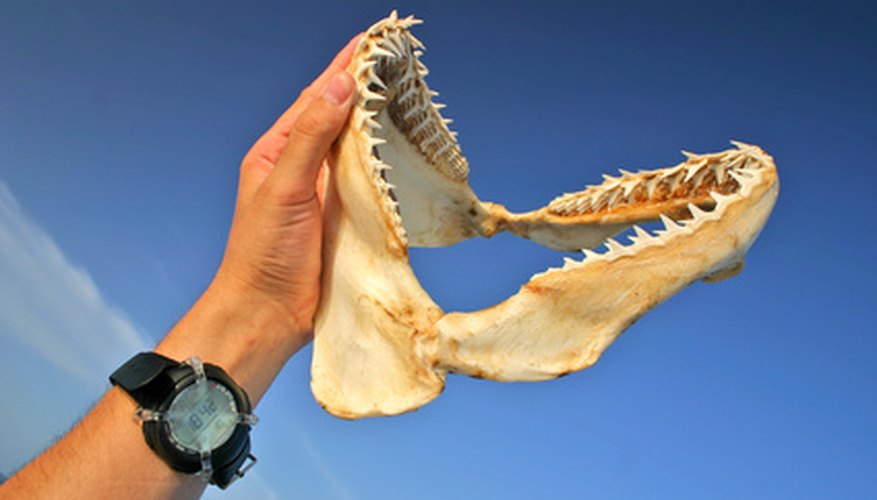Fisherman often wish to celebrate and remember the feat of catching a shark by mounting the jaws of the beast on a wall display. Once the shark has been caught and is confirmed dead, the flesh needs to be scraped away from the cartilage that holds the teeth in place. Practitioners disagree about the easiest means of scraping the meat from the cartilage, but every method must take caution to not dislodge the teeth from the cartilage. Once the teeth have been cleaned, they are ready to be dried and mounted.
- Fisherman often wish to celebrate and remember the feat of catching a shark by mounting the jaws of the beast on a wall display.
- Once the shark has been caught and is confirmed dead, the flesh needs to be scraped away from the cartilage that holds the teeth in place.
Extract the jaws from the shark carcase with the fillet knife after the shark is confirmed dead. Insert the fillet knife over the top of the jaw and work your way down to the left hinge. Repeat down to the right hinge and underneath.
Run the knife parallel to the jaw line, removing as much of the flesh as possible in small, smooth movements.
Scrape the meat off the jaws, taking care to not cut into the cartilage or loosen the teeth. This may be done with an X-acto knife or scalpel working in small diligent movements.
Pour bleach into a container large enough to submerge the jaws. Wearing gloves, dip the jaws into the bleach for 30 to 60 seconds at a time, scrubbing any excess flesh you were unable to scrape off. Rinse the jaws with water between soakings.
- Run the knife parallel to the jaw line, removing as much of the flesh as possible in small, smooth movements.
- Wearing gloves, dip the jaws into the bleach for 30 to 60 seconds at a time, scrubbing any excess flesh you were unable to scrape off.
Cut two sticks, one the length of the jaws from hinge to hinge and one the width of the jaws from top to bottom when the jaws are opened fully.
Place the sticks in position, holding the jaws open to dry. Place the jaws under a lamp and allow them to dry for four to five hours, then remove the sticks.
Paint three coats of epoxy on the jaws, placing the jaws in front of a fan to expedite the drying each coat.
- Place the sticks in position, holding the jaws open to dry.
- Paint three coats of epoxy on the jaws, placing the jaws in front of a fan to expedite the drying each coat.
Saw the mounting board the size and shape you want to display your jaws. You may use your creative judgment with this, cutting a circular, rectangular or other shape that suits your mount.
Paint or stain the mount board as you want, then allow it to dry.
Drill a hole into the cartilage hinge on either side of the shark jaws positioned over the wood mount. Make sure the holes line up properly.
Screw the jaws in place. Don't tighten the screws too heavily; this can cause the hinge to snap. Brush epoxy on the back of the jaws where it contacts the mount board to add additional support.
TIP
Bleach or hydrogen peroxide also give the teeth a white finish
WARNING
Leaving the jaws in bleach too long will dissolve the cartilage, ruining the jaws.
